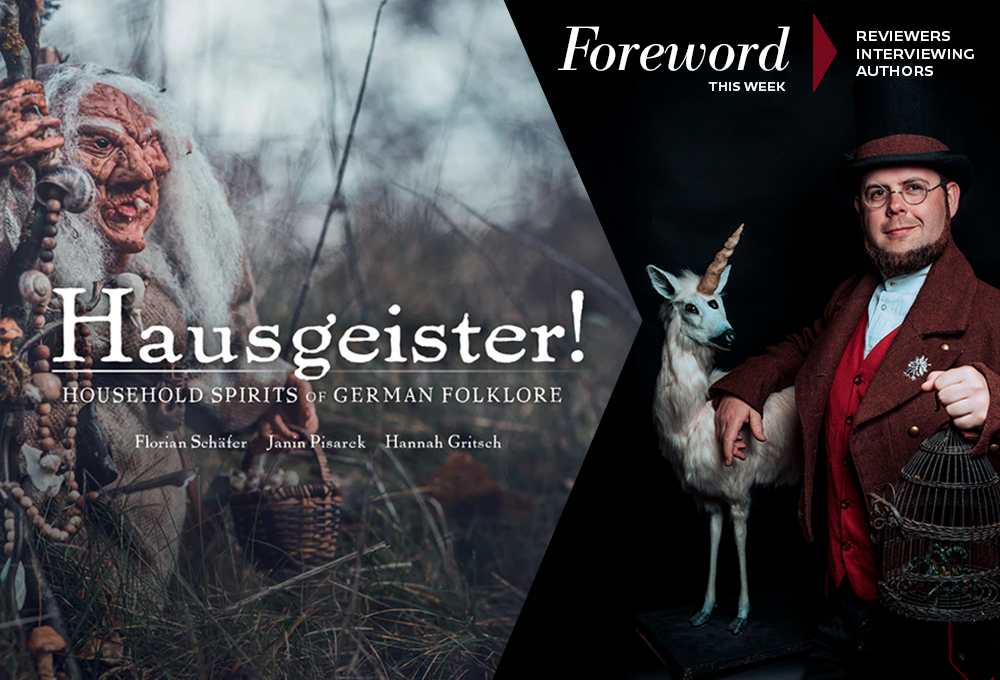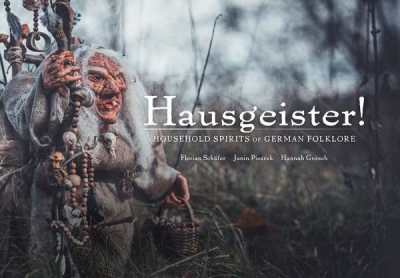Reviewer Rachel Jagareski Interviews Florian Schäfer and Janin Pisarek, Authors of Hausgeister!

All religions have trouble playing nice in the playground of life, but Christianity may deserve the biggest-bully-of-all title. See: the crusades, the inquisitions, and even the Holocaust, which only gained its foothold in Nazi Germany after centuries of antisemitism in Europe.
But today we’re going to look at an especially vulnerable target of Christian wrath: the wichtel, moosweibchen, draks, geldmannlein, kobolds, poltergeists, and other supernatural beings that used to inhabit the homes and wooded regions of Northern Europe. This time, the church chose to demonize the creatures as a means to combatting superstition overall.

Florian Schäfer and Janin Pisarek, are scholars of the house spirits of the German-speaking world—bet you didn’t know that major was available when you went to college—and their years of study led to the fascinating Hausgeister!, which earned a great review by Rachel Jagareski in the pages of Foreword.
Their conversation reveals that there wasn’t much to fear in these creatures. In fact, Rachel gets Florian and Janin to admit which spirit they’d invite into their own home.
Enjoy.
What distinguishes hausgeister from other traditional European supernatural beings and makes them uniquely German?
Florian: “Hausgeister” is a German term encompassing house or household spirits, supernatural entities that inhabit residences, castles, and mills in German folklore, fairy tales, and superstition. Comparable narratives can be found worldwide. While other nations maintain a vibrant tradition and engagement with these mythical themes, Germany lags somewhat behind, despite the influential legacy of the Brothers Grimm. These scholars were active in Germany, collecting and documenting numerous folk tales and legends. While Scandinavian troll tales and French fairy narratives are widely recognized, our own German legends are regrettably fading. Rooted in our heritage, we’ve chosen to spotlight lesser-known German variations and their distinctive facets through our “Forgotten Creatures” project. Consequently, our focus primarily centers on exploring beings originating from German-speaking regions.
Janin: The household spirits of German-speaking countries hold an intriguing blend of ambivalence and fascination, yet their distinctiveness is relatively modest. They exhibit uniqueness in names, some external features, and occasional character traits. However, analogous forms with similar roles and functions can be found in other European traditions. Old popular beliefs in supernatural beings aiding homes and yards while penalizing negativity and resulting narratives are widespread. Notably, there has been limited research on this subject, with only two dissertations on house spirits in Germany during the last century and minimal attention throughout Europe. British folklorist Dr. Simon Young humorously calls Hausgeister! the “most important ever published on British and Irish house spirits,” highlighting its significance within the broader European tradition. It can be said that the house spirits of the German-speaking world take on a representative function for comparable beings of other European traditions and it would be very interesting to examine and compare the European house spirits more closely with the methods of historic-comparatist narrative research.
Why do you think there has been resurgent interest in fantastic and mythical creatures in contemporary literature, films, games, and other types of popular culture?
Janin: Interest in the supernatural and the fantastical is likely to endure indefinitely, perhaps even intensifying with the progression of modernity, much like during the Romantic era. This affinity for the mythical offers a means of escape and a slowdown from the rapid pace of daily life. Amidst feelings of disorientation and rootlessness, supernatural entities in literature, films, games, and other facets of popular culture provide a constant presence. These characters, motifs, and narratives have captivated and intrigued people for millennia, shaping our cultural memory. Although they have faded from many corners of society, they remain a substantial part of our world.
Legendary figures have always held significance; they act as a mirror reflecting human behavior, highlighting misconduct, and thereby serving as regulators. They facilitate the portrayal of genuine problems, solutions, and perils through metaphor, rendering complex societal matters more comprehensible. Moreover, the allure of the unfamiliar has historically been potent and appealing—recall the myriad renowned travel accounts that satiated people’s appetite for sensation with depictions of absurd dog-headed beings or perilous man-eaters, centuries before.
The kobolds are an especially intriguing class of hausgeister with their changing roles as protectors of the home, as ancestral spirits, and as tricksters/pests. What do you think modern kobolds would be like and what role do you think they would serve?
Florian: While a continuous tradition of transmission for these mythical creatures is often challenging to prove from a historical standpoint, it’s incredibly fascinating to witness how people transformed the kobold (and many other mythical beings) over the centuries. The church’s efforts to combat superstition and its practice of “demonizing” (known as “Interpretatio Christiana”) pagan belief concepts usually play a pivotal role here. Additionally, “forgetting” and subsequent rediscovering older texts and traditions also contributed to this evolution.
Interestingly, the kobold underwent a captivating transformation in modern times into the now familiar and much more contemporarily rooted “poltergeists.” At first glance, the ghostly phenomena of modernity, now an integral part of pop culture, may seem to have little overlap. Yet, a closer examination of the kobold’s evolutionary history reveals striking similarities: the spirit of a deceased individual bound to a house or even a family, manifesting through knocking sounds, furniture movement, or even attacks on humans. On the flip side, the notion of a modern kobold is also quite alluring. In 1930, a German vacuum cleaner brand named their product “Kobold”—so perhaps today, it might opt for this device for its services.
Florian, your sculptural recreations are so evocative and essential to understanding the many types of hausgeister. What was your process in designing and fashioning them in your “mythatelier”?
Florian: Thank you so much. I find myself at the intersection of art and cultural communication. This is also reflected in how I approach the Mythatelier: Firstly, I meticulously research how people envisioned mythical creatures during long-gone times and how these descriptions evolved. It’s a time-consuming process that demands considerable effort. Often, information needs to be gathered from various sources, and sometimes there are gaps that I fill in with my interpretation. However, I aim to minimize injecting my “own imagination” into the figures. It’s a bit akin to reconstructing dinosaurs, which have evolved over time with new and improved data and fossil discoveries, resulting in a drastically different appearance today compared to a decade ago.
If historical depictions exist, of course, the process becomes easier. However, concerning household spirits, there are virtually no images prior to the early modern period, only written sources (and these were often recorded quite late, too). Ultimately, this is the distinguishing feature of Forgotten Creatures: We don’t aim to create folklore-inspired fantasy, but rather fantastical representations of folklore beings that people once genuinely believed in. We employ these representations in museum exhibitions, stage shows, and our books to ignite people’s enthusiasm for the cultural history behind these creatures.
The majority of hausgeister appear to be male, so I was happy to read your chapter about the variety of holzfraulein which are so wildly divergent; the little moss women are largely helpful to humans and seek their protection, while the larger forest women are wilder and are sometimes human’s erotic partners. Can you elaborate on why they might be so different in their relationship to humans?
Janin: When supernatural beings appear in communities, we almost always find both male and female among them. Communities, much like our own human societies, can’t exist without women, and the same applies to beings like Wichtel or the Moos folk. Traditional family concepts, such as marriage between a man and a woman and child-rearing, reflect the life situations of people in those times. However, the role of (supernatural) women varies widely. Apart from household spirits, watermen cruelly punish their daughters when they defy their father’s dictates. Almost all supernatural beings come into contact with humans in a variety of ways, whether on an erotic level or in connection with changelings.
The allure of the supernatural and the unknown in legends also leads to erotic relationships—interesting to note that in these narratives, these relationships are always heterosexual. A human woman can have an erotic relationship with a waterman, but never with a nix, while human men can only have relationships with Moosweibchen and so forth. But in order to go into more detail on the question of why the moss people are somewhat different from the classic house spirits in their relationship to humans, it should be noted that the Moosweibchen are more likely to be assigned to the forest and nature spirits than the other representatives in our book. Due to their frequent functions in the role of a helping house spirit, we have included them. In fact, they are very archaic and close to nature, which potentially awakens other longings.
Florian: We’re glad that at least the Moosweibchen step in to combat the patriarchy! (laughs) As Janin has already explained, supernatural societies often reflect human realities, which explains the prevalence of male-dominated societies among humanoid, culture-creating beings. The moss folk, who usually feature women in folk tales and are led by the “Buschgroßmutter,” are a delightful exception in this regard.
What kind of hausgeister would you both like to have around your house?
Janin: (laughs) That’s a good one, definitely. While the advantages of having a house spirit are appealing, one must exercise caution to avoid upsetting them. I must admit, I wouldn’t mind occasionally benefiting from the helpfulness of a Wichtel, the healing wisdom of a Moosweibchen, or even a little shower of gold over the fireplace from the Drak. However, engaging with the supernatural always comes with its challenges, as the book also emphasizes. So, I’m a bit uncertain. Can I ask the same question in return?
Rachel: I wouldn’t mind if a geldmannlein hung around to bring me some gold! However, I do love reptiles, so a dragon-like drak nestled around my chimney would be my preferred household spirit.
Florian: I suppose I’d choose a Wichtel for household cleaning; that would make life so much easier. More time for research and art … (sighs) Unfortunately, none of the Wichtel and Kobold in my workshop have taken a broom (or a vacuum cleaner) into their hands on their own so far.
Rachel Jagareski
